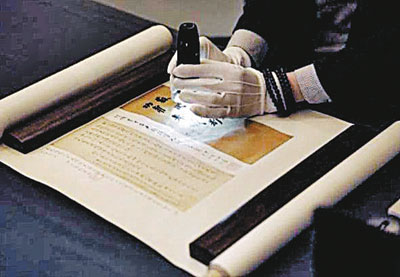|

A PIECE of ancient Chinese calligraphy, which went under the hammer for US$8.2 million from Sotheby’s in New York in September last year, went into the spotlight again recently, as the wealthy buyer told media in Beijing recently that an expert’s accusation that it was forged is “ridiculous.”
The buyer, Liu Yiqian, said that the expert, Yang Danxia, should provide more academic evidence making this type of accusation.
The scroll, “Gongfu Tie,” is claimed to have been made by the Song Dynasty poet Su Shi. The nine-character scroll is considered one of the greatest works of calligraphy, and it has seals indicating that it has been owned by other great Chinese artists and scholars.
Yang, a researcher from the calligraphy and painting department of the Palace Museum in Beijing, said in a statement recently that the calligraphy was “clearly a fake and anyone with a little knowledge in ancient calligraphy could tell immediately.” She was sued in Beijing on May 27 for defamation by the president of a Chinese auction company.
“Whether the calligraphy scroll was a fake or not has been debated for a while and many renowned experts have provided a lot of evidence and sources to defend their arguments,” Liu said. “However, it was irresponsible for Yang to make such a simple statement. If anyone could tell the scroll was a fake, why have other experts spent so much time debating it?”
Liu, 50, is a successful entrepreneur and co-founder of the Shanghai-based Long Museum.
In fact, in March, just months before it was set to go on display at Liu’s museum, three art historians in China declared the work a forgery, probably produced in the 19th century using an old method for copying and retracing artworks.
The art historians, who are affiliated with the State-owned Shanghai Museum, said the scroll was created between about 1820 and 1871 using stone carving, 800 years after Su died.
Sotheby’s issued a statement shortly after the allegations were made, saying that the auction house stood by the work and intended to investigate the matter.
“Sotheby’s firmly stands by the attribution of the ‘Gongfu Tie’ to the Song Dynasty poet Su Shi,” the auction house said. “We have not yet been presented with the coverage referenced in recent media reports, but take all matters of authenticity seriously and look forward to reviewing and responding to any questions raised. Sotheby’s adheres to the highest ethical standards in the marketplace and reserves all of its legal rights in this matter.”
Liu also said that he was surprised by the findings of the historians and that he would await a review by Sotheby’s and independent experts. “If the work turns out to be a forgery, he expects to get a refund,” Liu told the media earlier.
The work has gained approval from at least two late collecting masters, Liu said. Xu Bangda (1911-2012) and Zhang Congyu (1914-1963) hailed the artwork as a top-grade piece in their published manuscripts or anthologies.
“I’ve never heard any contrary opinion about the calligraphy before, but the controversy is a good thing. It will help reveal the truths of history,” Liu said. “Su stroked this work about 1,000 years ago, so nobody can be 100 percent sure that this is not a fake. But the possibility of the work being genuine is very large.”
The three historians are respectable scholars with profound expertise in the appraisal of ancient artworks, said the museum. One of them is the museum’s former director of Chinese painting and calligraphy Shan Guolin, and another is senior connoisseur Zhong Yinlan. The third researcher is Ling Lizhong.
When their statements were published on the Shanghai-based Xinmin Evening Post, a heated debate was sparked across the art collection industry.
Ma Weidu, founder of the country’s first private museum since 1949, Guanfu Museum, said that the incident was significant as it was the first open dispute between private and public museums. “According to the current policy, public cultural and museum organizations are not allowed to appraise collections for private collectors, which means that the country’s highest cultural relics verification department will not appraise ‘Gongfu Tie,’” Ma said. “The Chinese artwork market has developed very fast over recent years, but without supporting policies, it is difficult for private collectors to determine the authenticity of their collections.” (Wang Yuanyuan)
|

